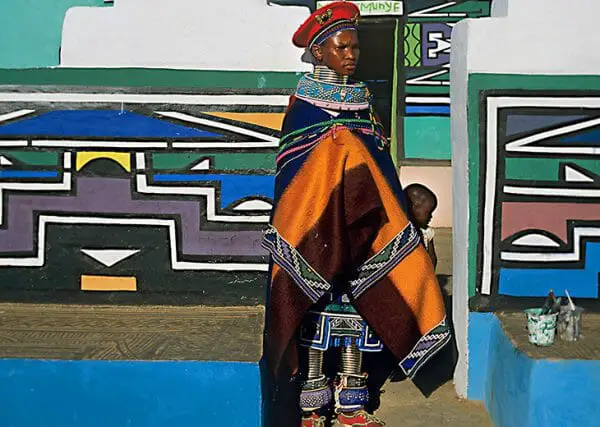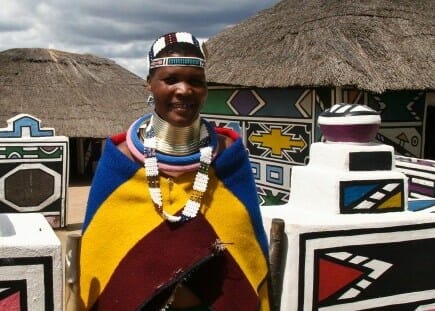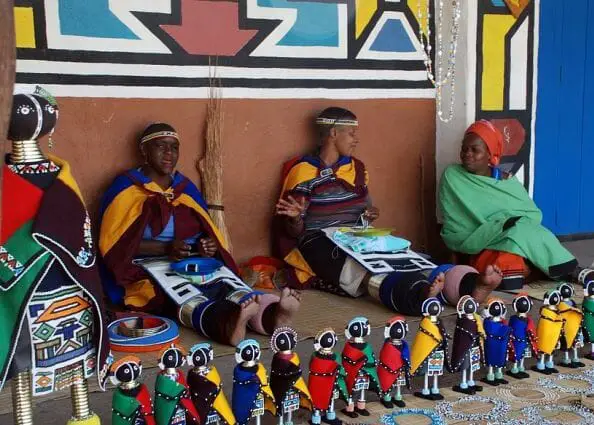
This is the third post in a series inspired by the Black Panther movie. Costume design plays an integral part in this movie’s success. Designer Ruth E. Carter and movie director Ryan Coogler went to great lengths to ensure that the tribal references in the movie are as authentic as possible. In this blog post series I’m looking at the tribes referenced in the film. In this third blog post, we will look at the Southern Ndebele Tribe of South Africa.
![]()
 Dora Milaje
Dora Milaje
In the Black Panther movie, the Dora Milaje are an elite group of female bodyguards and an integral part of the fictional country, Wakanda’s, special forces. This team of women is trained from birth to be some of the best fighters in the world, specialising in martial arts, hand-to-hand combat and weaponry. Their job is to protect the throne as well as the reigning king and Black Panther. The three most prominent warriors are General Okoye (Danai Gurira) – the head of the Wakanda Armed Forces; Ayo (Florence Kasumba) – head of King T’Challa’s security; and Nakia (Lupita Nyong’o) – a spy, king T’Challa’s love interest and a member of the War Dogs, Wakanda’s central intelligence agency.
Although one of the Dora Milaje’s main antecedents was the all-female military corps of Dahomey, West Africa (now the Republic of Benin) also known as the Dahomey Amazons, the costume designer, Ruth E Carter, used a much broader range of influences to create the striking red uniforms of these female warriors. Their armour was inspired by Japanese Samurai outfits and the deep red colour was inspired by Masai traditional dress. But I want to focus on the most striking part of these outfits – the metal neck rings inspired by the traditional dress of the Southern Ndebele tribe of South Africa.

Ndebele
Divided into two tribes, the Northern Ndebele lives in modern-day Zimbabwe and the Southern Ndebele lives on the highveld areas of north-eastern South Africa. Ndebele is a Nguni tribe, a group that also include the Zulu, Swazi, and Xhosa people. The Southern Ndebele people are most known for their colourful, highly decorated homes and beaded traditional dress.
Ndebele traditional art and craft

Painted homesteads (umuzi)
In striking contrast to their highveld surroundings, the Ndebele homesteads are colourful, vibrant and highly decorated. The women adorn their homes with dazzling geometric designs which they paint freehand. Although they plan their designs they don’t mark it out on the walls. Traditionally they used colours and dyes available in nature but has over time adopted commercial paint as their preferred medium, offering a broader range of colours. They do not assign any symbolic meaning to a colour, it is purely decorative. The façade of the house and the surrounding garden walls with a dominant gated entrance are usually decorated in bright colours with the side and back walls painted in muted browns, blacks and whites.
 Dress and adornments:
Dress and adornments:
Second only to their brightly coloured homes, are the Ndebele women’s highly decorated clothes and adornments. Beads were introduced to Africa by the Portuguese traders in the sixteenth century and have since become synonymous with African tribal dress.
A Ndebele women’s dress shows her age and status within the community. Married women usually wear several beaded grass hoops or isigolwani around her neck and legs. She also wears the now famous copper or brass rings known as indzila around her neck and legs. These are a gift from a man to a woman on their wedding day. Married women also wear a beaded skirt or apron. The beaded everyday skirt is called aamaphotho and the five-panel ceremonial skirt is called a tshogholo.
 Blankets
Blankets
Umbhalo blankets are usually worn draped over the shoulders of married women. The traditional blanket has broad coloured stripes in green red blue, yellow and brown.
 Dolls:
Dolls:
These dolls are usually referred to as Linga Kobe dolls, although that is only one of several types of traditional Ndebele doll. The dolls have different symbolic meanings and are used in different ceremonies and life events such as during initiation, when a young man asks for a woman’s hand in marriage, during the marriage ceremony and as a symbol of fertility by young married women, and when seeking guidance from a sangoma or spiritual diviner.
 Modern-day Ndebele:
Modern-day Ndebele:
Today, very few Ndebele homesteads still exist as most people now live a modern 21st-century lifestyle in modern houses. The brass rings have become a fashion statement like any other jewellery or adornment. The blankets are available at retail stores and the dolls are mostly usually sold as curios or tourist attractions.
Links and further reading:
 Margaret Courtney-Clarke has published a beautifully photographed book about the Ndebele with wonderful photos of homesteads, artwork, and beading.
Margaret Courtney-Clarke has published a beautifully photographed book about the Ndebele with wonderful photos of homesteads, artwork, and beading.

Mahlangu recently opened her exhibition at the Melrose Gallery where her series of artwork inspired by Nelson Mandela was unveiled on March 1. The artist has produced six paintings reproduced from drawings created by Mandela in her signature Ndebele style. The exhibition will include previous work by Mahlangu. / AFP PHOTO / GULSHAN KHAN
Esther Mahlangu is a world-renowned Ndebele artist whose work has been exhibited across the globe.



